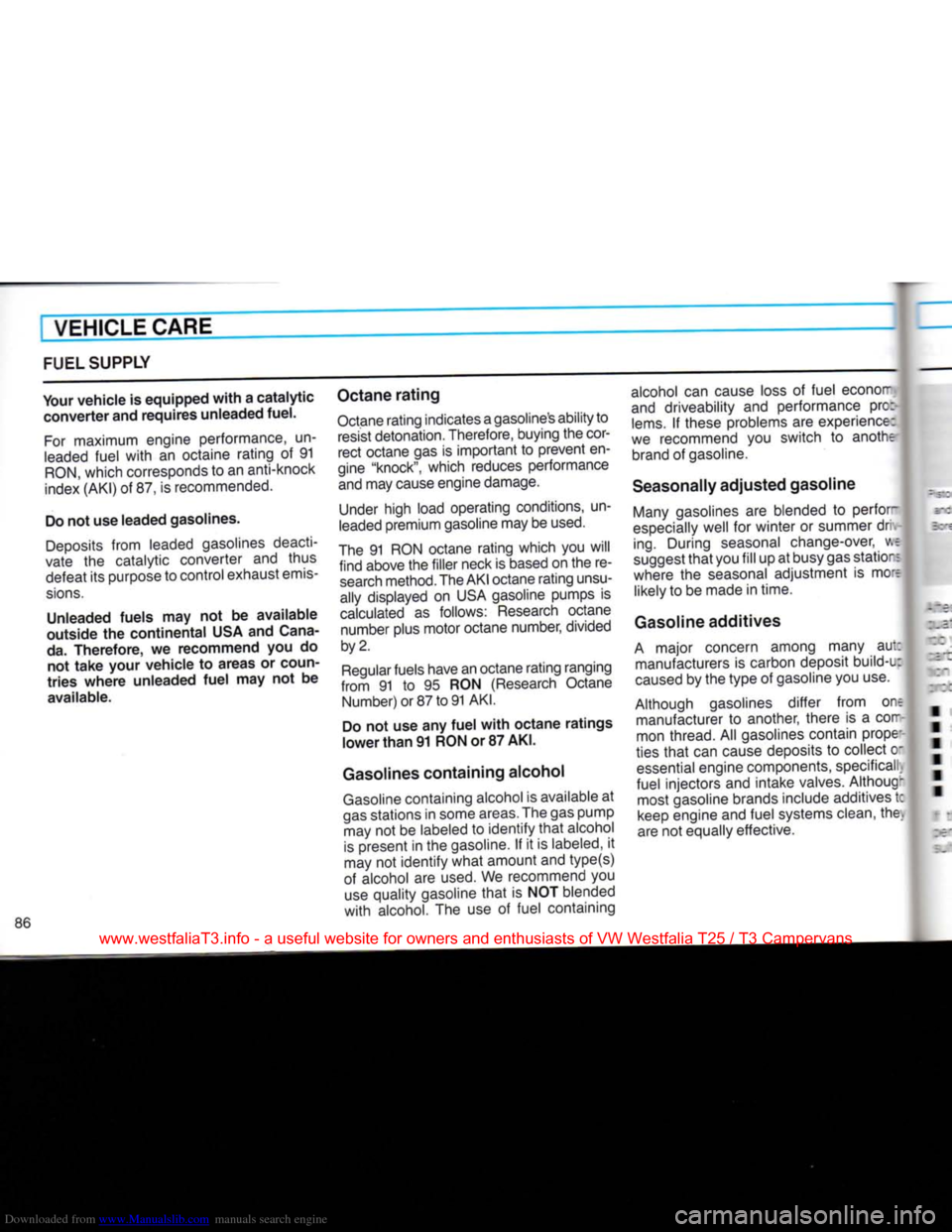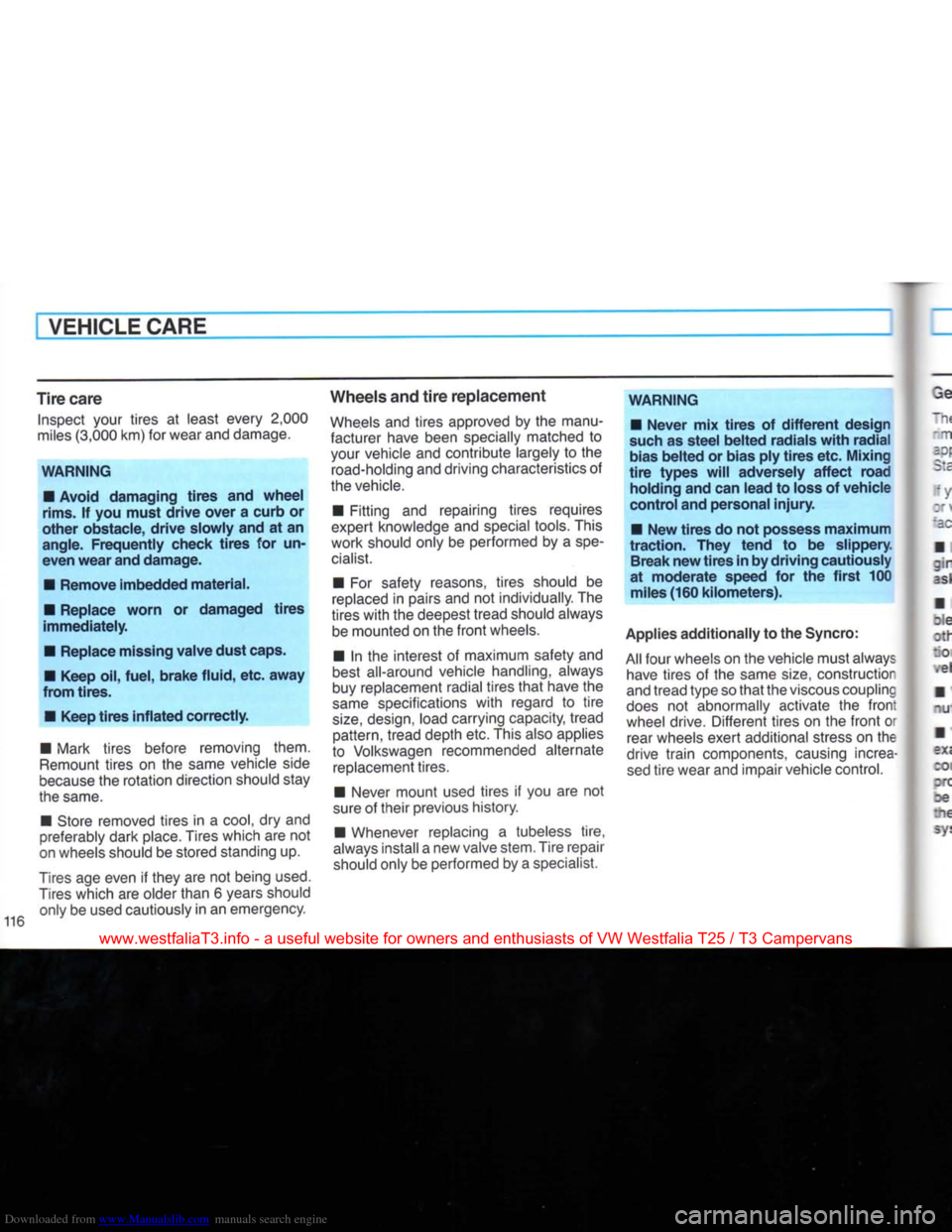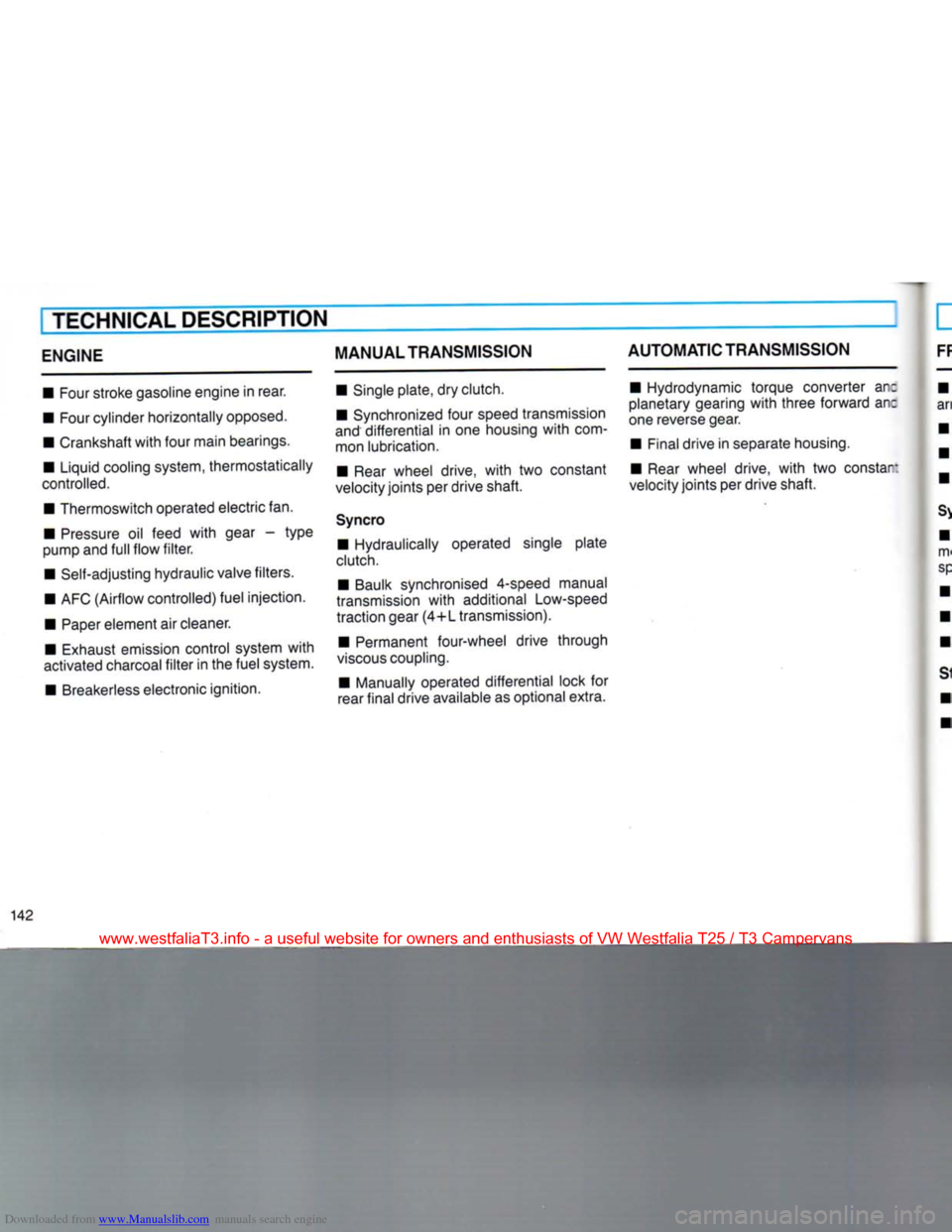1990 VOLKSWAGEN TRANSPORTER fuel type
[x] Cancel search: fuel typePage 91 of 165

Downloaded from www.Manualslib.com manuals search engine
VEHICLE CARE
FUEL SUPPLY
Your vehicle is equipped with a catalytic converter and requires unleaded fuel.
For maximum engine performance, un
leaded fuel with an octaine rating of 91
RON,
which corresponds to an anti-knock
index (AKI) of 87, is recommended.
Do not use leaded gasolines.
Deposits from leaded gasolines deacti
vate the catalytic converter and thus
defeat its purpose to control exhaust emis
sions.
Unleaded fuels may not be available
outside the continental USA and Cana
da.
Therefore, we recommend you do not take your vehicle to areas or coun
tries where unleaded fuel may not be
available. Octane rating
Octane rating indicates a gasoline's ability to
resist detonation. Therefore, buying the cor
rect octane gas is important to prevent en
gine "knock", which reduces performance and may cause engine damage.
Under high load operating conditions, un
leaded premium gasoline may be used.
The 91 RON octane rating which you will find above the filler neck is based on the re search method. The AKI octane rating unsu-
ally displayed on USA gasoline pumps is
calculated as follows: Research octane number plus motor octane number, divided
by 2.
Regular fuels have an octane rating ranging
from 91 to 95 RON (Research Octane Number) or 87 to
91
AKI.
Do not use any fuel with octane ratings
lower than 91 RON or 87 AKI.
Gasolines containing alcohol
Gasoline containing alcohol is available at
gas stations in some areas. The gas pump may not be labeled to identify that alcohol
is present in the gasoline. If it is labeled, it
may not identify what amount and type(s)
of alcohol are used. We recommend you
use quality gasoline that is NOT blended
with alcohol. The use of fuel containing alcohol can cause loss of fuel econorr
and driveability and performance pre:
lems.
If these problems are experience:
we recommend you switch to anothe brand of gasoline.
Seasonally adjusted gasoline
Many gasolines are blended to perfor-
especially well for winter or summer drl
ing.
During seasonal change-over, wl
suggest that you fill up at busy gas statior I
where the seasonal adjustment is mo-r likely to be made in time.
Gasoline additives
A major concern among many aut: manufacturers is carbon deposit build-i:
caused by the type of gasoline you use.
Although gasolines differ from onr manufacturer to another, there is a cor-
mon thread. All gasolines contain props'
ties that can cause deposits to collect ad essential engine components, specificali
fuel injectors and intake valves. Althoug- most gasoline brands include additives tc
keep engine and fuel systems clean, the;,
are not equally effective.
www.westfaliaT3.info - a useful website for owners and enthusiasts of VW Westfalia T25 / T3 Campervans
Page 121 of 165

Downloaded from www.Manualslib.com manuals search engine
VEHICLE CARE
Tire
care
Inspect your tires at least every 2,000
miles (3,000 km) for wear and damage.
WARNING
• Avoid
damaging
tires
and
wheel
rims.
If you
must
drive
over
a
curb
or
other
obstacle,
drive
slowly
and at an
angle.
Frequently
check
tires
for un
even
wear
and
damage.
•
Remove
imbedded
material.
•
Replace
worn
or
damaged
tires
immediately.
•
Replace
missing
valve
dust
caps.
• Keep oil,
fuel,
brake
fluid,
etc.
away
from
tires.
• Keep
tires
inflated
correctly.
• Mark tires before removing them.
Remount tires on the same vehicle side
because
the rotation direction should stay
the same.
• Store removed tires in a
cool,
dry and
preferably dark place. Tires which are not
on wheels should be stored standing up.
Tires
age even if they are not being
used.
Tires
which are older than 6 years should only be used cautiously in an emergency.
Wheels
and
tire
replacement
Wheels
and tires approved by the manu
facturer have been specially matched to
your vehicle and contribute largely to the road-holding and driving characteristics of
the vehicle.
• Fitting and repairing tires requires
expert knowledge and special tools. This
work should only be performed by a
spe
cialist.
• For safety reasons, tires should be
replaced
in pairs and not individually. The
tires
with
the deepest tread should always be mounted on the
front
wheels.
• In the interest of maximum safety and
best all-around vehicle handling, always
buy replacement radial tires
that
have the
same
specifications
with
regard to
tire
size,
design, load carrying capacity, tread pattern, tread depth etc. This also applies
to Volkswagen recommended alternate replacement tires.
• Never mount used tires if you are not
sure of their previous history.
• Whenever replacing a tubeless tire,
always install a new valve stem. Tire repair
should only be performed by a specialist.
WARNING
•
Never
mix
tires
of
different
design
such as
steel
belted
radials
with
radial
bias
belted
or
bias
ply
tires
etc.
Mixing
tire
types
will
adversely
affect
road
holding
and can
lead
to loss of
vehicle
control
and
personal
injury.
• New
tires
do not possess
maximum
traction.
They
tend
to be
slippery.
Break
new
tires
in by
driving
cautiously
at
moderate
speed for the
first
100
miles
(160
kilometers).
Applies
additionally
to the Syncro:
All
four wheels on the vehicle must always have tires of the same
size,
construction
and tread type so
that
the viscous coupling
does
not abnormally activate the
front
wheel drive. Different tires on the
front
or rear wheels exert additional stress on the
drive
train
components, causing increa
sed
tire
wear and impair vehicle control.
www.westfaliaT3.info - a useful website for owners and enthusiasts of VW Westfalia T25 / T3 Campervans
Page 147 of 165

Downloaded from www.Manualslib.com manuals search engine
I TECHNICAL
DESCRIPTION
ENGINE
MANUAL
TRANSMISSION
AUTOMATIC
TRANSMISSION
• Four stroke gasoline engine in rear.
• Four cylinder horizontally opposed.
• Crankshaft
with
four main bearings.
• Liquid cooling system, thermostatically
controlled.
• Thermoswitch operated electric fan. • Pressure oil feed
with
gear - type
pump and
full
flow
filter.
• Self-adjusting hydraulic valve filters.
• AFC (Airflow controlled) fuel injection.
•
Paper
element air cleaner.
• Exhaust emission control system
with
activated charcoal
filter
in the fuel system.
• Breakerless electronic ignition. • Single plate, dry clutch.
• Synchronized four speed transmission
and'
differential in one housing
with
com
mon lubrication.
•
Rear
wheel drive,
with
two constant
velocity joints per drive shaft.
Syncro • Hydraulically operated single plate
clutch.
• Baulk synchronised 4-speed manual
transmission
with
additional Low-speed
traction gear (4+L transmission).
• Permanent four-wheel drive through
viscous
coupling.
• Manually operated differential lock for
rear final drive available as optional extra. • Hydrodynamic torque converter an:
planetary gearing
with
three forward an:
one reverse gear.
• Final drive in separate housing.
•
Rear
wheel drive,
with
two constar:
velocity joints per drive shaft.
www.westfaliaT3.info - a useful website for owners and enthusiasts of VW Westfalia T25 / T3 Campervans